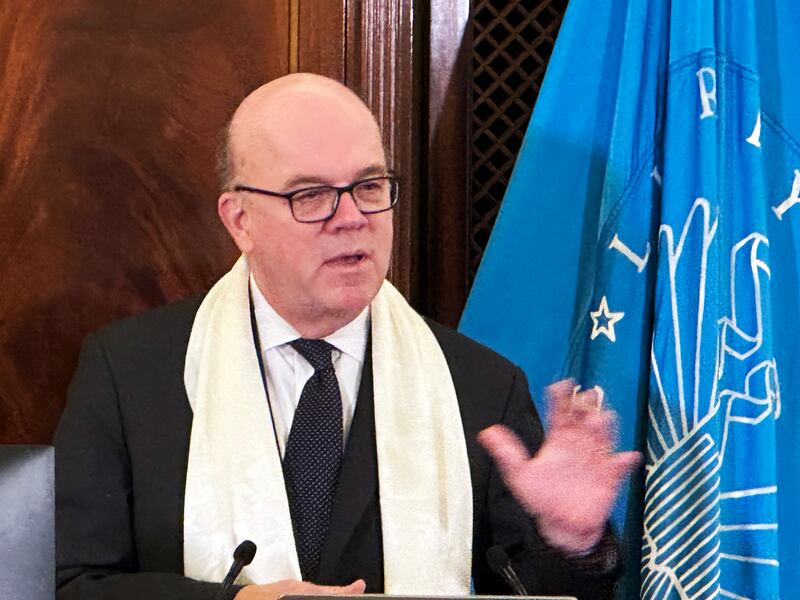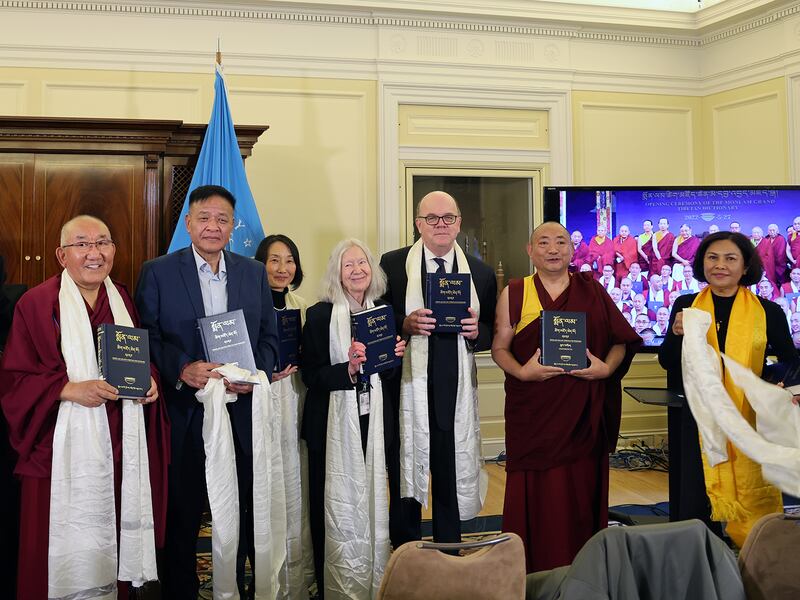Read RFA coverage of the story in Tibetan.
A new 223-volume Tibetan dictionary containing definitions of over 300,000 words presented to the Library of Congress last week will play a key role in preserving the Tibetan language amid China’s assimilation policies in the region, U.S. lawmakers and advocates said.
The Monlam Grand Tibetan Dictionary project, which began in 2012 under the advice and guidance of the Dalai Lama, Tibetan Buddhism’s spiritual leader, took 150 people working over nine years to complete. It is one of the largest dictionaries in the world.
The project was overseen by the Monlam Tibetan IT Research Centre in Dharamsala, India. The education software development firm founded in 2012 is funded by The Dalai Lama Trust, The Tibet Fund and the United States Agency for International Development.
The dictionary is written entirely in the Tibetan script.

All 223 volumes in hardback format were presented to the Library of Congress in Washington DC on Dec. 12 as a “gift to the U.S. government and the American people.”
A free digital version of the dictionary is accessible for all on various iOS and Android apps.
‘An incredible resource’
U.S. Congressman Jim McGovern, a Massachusetts Democrat who was at the ceremony, called it “an incredible resource that will help preserve the Tibetan language for future generations” while highlighting China’s attempts to phase out Tibetan, such as forcing Tibetan children to attend Mandarin-only boarding schools.
Geshe Lobsang Monlam, founder and chief executive officer of Monlam Tibetan IT Research Centre, said the project was a “true community effort.”
It “involved the participation of many editors, scholars and heads of different Tibetan Buddhist religious traditions, which is why I take great pride in saying that this dictionary is truly representative of Tibetan culture,” Monlam told RFA Tibetan on the sidelines of the event.
“It will benefit not just the Tibetan people in our preservation of our language but also others, including in the U.S. and China, in imparting our ancient knowledge and culture,” he said.

The dictionary was given to the Library of Congress because “Tibetans have shared a long friendship and shared values with the American people,” he said. “We have also enjoyed the support of the U.S. government in the preservation of our culture, language and religious traditions.”
“This dictionary serves as proof of the fruits of that relationship and support,” he said.
Other speakers and guests at the Dec. 12 event included Tibetan government-in-exile leader Sikyong Penpa Tsering, International Campaign for Tibet President Tencho Gyatso, and representative Namgyal Choedup of the Office of Tibet in North America.
Bridging the gap
The dictionary project began as an effort to bridge the gap between the modern and ancient by developing the vocabulary and terminologies necessary in the Tibetan language to keep pace with the changing world and technological advancements, Monlam said.
The dictionary preserves the unique lexicographical system in Tibetan while incorporating the standard principles and the practices of modern dictionaries from other countries, said Monlam, a Buddhist monk, scholar and IT innovator.

The Monlam Tibetan IT Research Centre has been on the cutting edge of preserving the language. In 2023, it created software that uses AI to translate written and spoken Tibetan into English, Chinese and other languages faster and more accurately than any existing translation software.
Work on the dictionary is expected to continue for the next decade as the team continues to update it.
The Library of Congress’s Tibetan Collection, established in 1901, is one of the largest in the West, including the entire corpus of Tibetan literature from the 8th century to the present.
These include Buddhist and Bon-po philosophical texts and their commentaries, historical biographies, musical notations, the collected works of over 200 major Tibetan authors, bibliographies, and texts on linguistics, modern science, the social sciences and modern literature.
The library’s Tibetan Collection currently holds 17,000 treatises, 3,600 rare volumes, 57 different periodicals and over 15,000 photographic prints.
Additional reporting by Palden Gyal and Yeshi Tashi. Edited by Tenzin Pema for RFA Tibetan, and by Roseanne Gerin and Malcolm Foster.
